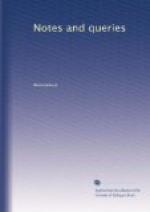“I sing the warre made in the Holy
Land,
And the Great Chiefe that Christ’s
great tombe did free:
Much wrought he with his wit, much with
his hand,
Much in that braue atchieument suffred
hee:
In vaine doth hell that Man of God withstand,
In vaine the worlds great princes armed
bee;
For heau’n him fauour’d;
and he brought againe
Vnder one standard all his
scatt’red traine.”
Queries.—1. Does the above variation occur in any or many other copies of the edition of 1600?
2. Which reading is followed in the second old edition?
T.N.
Demerary, September 11. 1850.
* * * * *
MINOR QUERIES.
Jeremy Taylor’s Ductor Dubitantium.—Book I. chap. 2. Rule 8. Sec. 14.—
“If he (the judge) see
a stone thrown at his brother judge, as happened
at Ludlow, not many years
since.”
(The first ed. was published in 1660). Does any other contemporary writer mention this circumstance? or is there any published register of the assizes of that time?
Ibid. Chap. 2. Rule 3. Sec. 32.—
“The filthy gingran.”
Apparently a drug or herb. Can it be identified, or its etymology pointed out?
Ibid. Sec.. 50.—
“That a virgin should
conceive is so possible to God’s power, that
it
is possible in nature, say
the Arabians.”
Can authority for this be cited from the ancient Arabic writers?
A.T.
First Earl of Roscommon.—Can you or any of your correspondents put me on any plan by which I may obtain some information on the following subject? James Dillon, first Earl of Roscommon, married Helen, daughter of Sir Christopher Barnwell, by whom he had seven sons and six daughters; their names were Robert, Lucas, Thomas, Christopher, George, John, Patrick. Robert succeeded his father in 1641, and of his descendants and those of Lucas and Patrick I have some accounts; but what I want to know is, who are the descendants of Thomas (particularly), or of any of the other three sons?
Lodge, in his Peerage, very kindly kills all the sons, Patrick included; but it appears that he did not depart this life until he had left issue, from whom the late Earl had his origin. If Lodge is thus wrong in one case, he may be in others, and I have reason to believe that Thomas left a son settled in a place in Ireland called Portlick.
FRANCIS.
St. Cuthbert.—The body of St. Cuthbert, as is well known, had many wanderings before it found a magnificent resting-place at Durham. Now, in an anonymous History of the Cathedral Church of Durham, without date, we have a very particular account of the defacement of the shrine of St. {326} Cuthbert, in the reign of Henry VIII. The body was found “lying whole, uncorrupt, with his face bare, and his beard as of a fortnight’s




